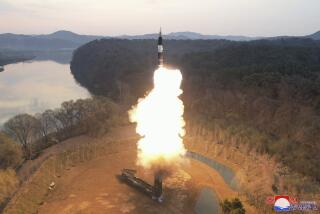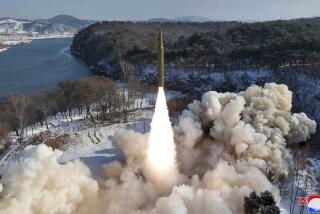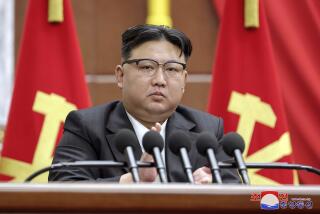North Korea not a nuclear threat to U.S. yet, scientist says
PALO ALTO — Siegfried Hecker is a former director of the Los Alamos National Laboratory and a professor at Stanford. But his knowledge of the North Korean nuclear program is not purely academic.
He has visited North Korea seven times and toured the nuclear facilities. He even held a sample of North Korean-made plutonium (albeit well protected in a glass jar). In an email interview this week after North Korea’s third nuclear test, he was asked a series of questions, including the most obvious:
How worried should the United States be? Can North Korea threaten the American mainland with a nuclear weapon, especially with December’s satellite launch?
No, they have yet to demonstrate that they have developed an intercontinental ballistic missile. To do so would require much more flight-testing of their long-range missiles. In addition, the nuclear device would have to be very small and light, which would require additional nuclear tests. The nuclear warheads would also have to survive the demanding mechanical and thermal stresses of reentry into the atmosphere.
Hence, they are many years away from threatening the United States; besides why would they want to strike the United States? It would be suicidal and the regime is not suicidal.
Why did North Korea need to conduct a nuclear test at this time? What from a technical standpoint were they trying to achieve?
With its limited nuclear test experience, North Korea needed a third test to demonstrate that it can miniaturize a nuclear device; that is, make it sufficiently small and light to mount on one of its missiles. This test may have given them the confidence to do so for one of their shorter-range missiles.
The 2006 and 2009 tests demonstrated that North Korea can build a nuclear device, but that its nuclear arsenal is likely restricted to bulky devices that would need to be delivered by plane, boat or van, thereby greatly limiting their deterrent value. With a missile-capable nuclear device, [the government in] Pyongyang enhances the credibility of its deterrent.
How can we tell if it was a plutonium or uranium bomb? Which one is potentially more worrisome?
The seismic signals can only identify the size of the explosion, not its content or its sophistication. The gaseous fission products of the explosion provide different telltale signatures for highly enriched uranium and plutonium devices. However, these have to escape from the deep underground test cavity and be detected and analyzed very rapidly by airborne instruments or radiological monitoring stations around the world to allow conclusive identification. One has to be lucky to do so.
Both plutonium and uranium bombs are worrisome. What is troubling about North Korea using highly enriched uranium is that we don’t know how much it has and how much it might produce in the future because it is easy to hide its production facilities. In contrast, North Korea has very little plutonium, perhaps enough for four to eight bombs, and it is not making any more.
Do you think there is a possibility of another nuclear test or two in the days to come?
The regime of Kim Jong Un has threatened unspecified “second and third measures of greater intensity.” These threats may be additional long-range missile tests, another nuclear test or both.
I had considered it quite possible that they may conduct two nuclear tests simultaneously. Since they did not, they may have another nuclear device ready to test and they have another test tunnel, what we call the South Portal, ready to go.
You were shown North Korea’s centrifuges for enriching uranium in 2010. What was your impression of the state of the technology? Do you have any thought on how a country as poor and isolated as North Korea could have built such a facility? At the time was it your impression that the uranium program was for civilian purposes?
In spite of their repeated denial of having a uranium enrichment program, I knew they had one. However, I was stunned at the size and sophistication of the 2,000-plus-centrifuge facility I was shown. It was another lesson that one should not underestimate the skill and determination of the North Koreans. They had developed these capabilities over at least a couple of decades with the help of a sophisticated, clandestine procurement network, significant help from Pakistan’s A.Q. Khan, and great indigenous engineering skill.
I believed the Yongbyon centrifuge facility was dedicated to making low-enriched uranium reactor fuel for its new experimental light-water reactor. However, I was also convinced that they had to have a covert facility and that facility was likely making highly enriched uranium bomb fuel. In addition, the Yongbyon facility can easily be converted from reactor fuel to bomb fuel production.
Why did the North Koreans allow you see their nuclear facilities? Bragging rights? In order to open a door for negotiations? Have they now closed that door?
I have been to North Korea seven times. Although they did not specifically say so, they had a message for me to deliver to the U.S. government each time. The first time, in 2004, when they let me hold the plutonium they had just made — I should add that it was well protected in a glass jar — the message was to tell the Bush administration that they have the bomb. I believe it was an attempt to negotiate, obviously with a trump card for their side.
Unfortunately, they did not get the kind of response they wanted, so they went ahead and tested a bomb in 2006. When that one did not work so well, they greeted President Obama in 2009 with a second test that worked. Now they are greeting incoming South Korean President Park Geun-hye and a second Obama administration with the prospects that they may have miniaturized a nuclear device.
Perhaps the greatest impact of this nuclear test is that it will signal that the Kim Jong Un regime, like its predecessors, has chosen bombs over electricity. It will now be difficult to look for resolution of long-standing enmities on the Korean peninsula by focusing on issues beyond the nuclear dispute.
Normalization of relations, a peace treaty, access to energy and economic opportunities — those things that come from choosing electricity over bombs and have the potential of lifting the North Korean people out of poverty and hardship — will be made much more difficult, if not impossible, for the next five years, if not longer.
More to Read
Start your day right
Sign up for Essential California for news, features and recommendations from the L.A. Times and beyond in your inbox six days a week.
You may occasionally receive promotional content from the Los Angeles Times.






